Introduction
In a global environment of rapid increases in health expenditures, health policies in Australia and in many other countries are currently undergoing major reforms. To contain future cost increases, accurate tools able to identify and rank ‘best value for money’ health investments are essential.
In Australia non-communicable chronic diseases – e.g. diabetes, heart disease, cancer, arthritis and mental disorders – affect the majority of the elderly, account for 70% of health expenditures, and cause poor health, deteriorating quality of life and premature death. This book focuses on how to identify ‘best value for money’ health investments within the context of on-going and future health reforms, and on quantifying the major benefits that would flow from such investments in terms of longer and better lives. This book will be of interest to general readers, social and economic researchers, and students interested in health care in ageing populations.









